It’s that time of year when smartphone giants Apple and Samsung announce their new models. Yes, there are other smartphone companies that produce pretty good phone like Google and LG but Apple and Samsung pretty much dominate the market. It has been that way since mobile phones made their transition to the smartphone. However, there have been some notable flops as companies have sought to introduce their own idea of what a smart phone should be. Here are some the biggest smartphone flops.
Sure, there are others. You may even think your current smartphone should be on the list but I’m sure no one will disagree with the phones listed below. Have fun reading. If you can think of some notable ones to add to the list, let us know.
Amazon’s Fire Phone (2014)

Yeah, you may have forgotten about Amazon’s attempt to hop into the smartphone market but that is exactly what they tried to do June 2014 with the release of the Amazon Fire Phone. Despite some features on the phone that were top end for the time, like a 13-megapixel camera and dual Dolby stereo speakers, the phone didn’t take off at all, forcing Amazon to take a $170 million write down.
There are several reasons for the Fire Phone’s lack of appeal. Let’s start with its price. For the same reason many phones have failed in the past, they roll to market at a price point equivalent to the iPhone and Samsung’s Galaxy phones. That’s what Amazon did. For a company with a history of undercutting its competition, that was a surprise. To give the company credit, it did lower the price relatively quickly but by then there wasn’t any interest from iPhone and Galaxy users to switch.
The Fire Phone also suffered from relatively small number of available apps. Amazon’s app store has, and continues to be, relatively small compared to the Apple and Google stores. Yeah, you can sideload but who wants to do that. So, the Amazon Fire Phone joins the list of the biggest smartphone flops.
Windows Phone (2010) – The Biggest Smartphone Flops

November 2010, the first wave of Windows Phones hit the market using the Windows Phone 7 operating system. That version of Microsoft’s mobile operating system lasted about two years before the release of Windows Phone 8, which was based on a new kernel. That version of the mobile OS lasted about three years until Windows 10 Mobile released. Windows 10 Mobile lasted for two years until in October 2017, Microsoft killed its Windows Phone venture which was designed to compete with Apple’s iOS and Google’s Android systems.
The above just gives you some context and timeline for release of the Windows Phones and its demise. However, why did it fail. Microsoft has deep pockets and even acquired phone company Nokia in 2013 after partnering with the Finnish company in 2011 to help roll out is mobile OS. We’ll say this, Windows Phone did not fail due to its hardware, imaging, battery life or any other aspect of the phone. They were good phones. In fact, the Lumia had one of the best cameras you could find in smart phone when it was released 2013.
From a feature’s standpoint, the Windows Phones were good. You might even say excellent. Enough to compete with Apple and Samsung. Not quite. Again, price points for the Windows Phones were generally on par with the smartphone giants and, as pointed out above with Amazon, the number of apps for Windows Phones were nowhere near what you could get through the Apple and Google stores.
Samsung Galaxy Round (2013)

In October 2013, Samsung took the wraps off what it thought would be the precursor to its next generation of smartphones with the Samsung Galaxy Round – a phone with a curved display. Originally released just in South Korea, the phone did expand its distribution in July 2014. You might think, cool. That sounds like it would be a winner. After all, the company had also released curved OLED HDTV models. So why did the Galaxy Round fail?
In a nutshell, price. You could get that cool phone, which was basically a Samsung Note 3 without the pen and curved display, for around $1,149. You might say, that’s on par with a good Galaxy smartphone. Not in 2013 and 2014. Compared to a Galaxy Note 3 that sold for $299 with a two-year contract, well why would you want a curved version of the phone and without a pen. Nuff said.
The BlackBerry Storm (2008) – The Biggest Smartphone Flops

Remember Research In Motion and its BlackBerrry phones? Back in 2008, a BlackBerry phone was a business essential. If you didn’t have one, well you wished you did. The email security and thumb-clicking keyboard just under the display were all things that endeared the BlackBerry phones to its users. With the BlackBerry Storm though, Research In Motion decided it wanted to make a foray into the consumer market, something it hoped would allow it to compete with the iPhone.
Unfortunately, that didn’t pan out. The Blackberry Storm. Priced at $199, the BlackBerry Storm was about the same price as an iPhone 3G. However, there were stark differences. For one, the Blackberry Storm was heavy and bulky compared to the iPhone. Yes, that bulk was for an extended battery but the weight of the phone just didn’t appeal to people. Setup was also much more difficult than the iPhone. But perhaps the killer was the touch screen. You could say it was a good first effort but that would be giving too much praise to the touch screen technology. The BlackBerry Storm touch screen was awful and so was the onscreen keyboard. For BlackBerry users who loved the thumb-clicking phone keyboards, the terribly bad onscreen keyboard was enough to turn them off. Sadly, if you’re going to compete against the iPhone to appeal to the consumer market, you better do what they do better. Otherwise, stick to your niche.
HTC First aka the Facebook phone (2013)

Yes, there was a Facebook phone. It was called the HTC First. It was released April 2013 for $99 and a month later, the price dropped to $0.99. Yeah, you read right – 99 cents. You would think the stars would align on this one. HTC had successful launch after successful launch of their phones and Facebook had the consumer brand you would think would be able to propel a phone forward. Alas, that wasn’t to be the case.
HTC’s first unsuccessful launch can be summed up in two words: Facebook Home. The Android layer that featured Facebook Home dominated every aspect of the user experience on the phone. So much so, that users couldn’t easily get to their other favorite apps. Also, while it was great to experiment with a phone built around Facebook’s new software, but if you could get Facebook Home as an app on other phones that had better hardware and features, what was the point? Like the Galaxy Round, just because you can, doesn’t mean you should. Hence, the reason why this may be one of the biggest smartphone flops.
Samsung Galaxy Beam (2012) – The Biggest Smartphone Flops

Wow. Two Galaxy phones on this list. There is one thing about Samsung – they are not afraid to experiment. So, what was the Galaxy Beam and why is it on the flop list when it has spawned several subsequent versions, including the Pro, which we’ve heard may be released soon.
The Galaxy Beam was, and is, a projector phone. The idea was to release a phone and stuff a projector into its hardware. The result is that you can project whatever is on your phone onto a flat surface. Companies pay thousands of dollars to place projectors in their conference rooms. With the Galaxy Beam, you could get a projector for approximately $430 in 2012. So what gives?
The first is price. While the Galaxy Beam did have a lot of features from the S series, the higher price compared to an S3 at the time wasn’t worth the novelty for most people. The other was the effectiveness of the beam. Yes, you could project your phone content onto any flat surface so long as it was a light-colored surface and you were in the dark. Otherwise, the projection was iffy.
To be fair, Samsung has improved the Beam and it does have a niche, but if you want to project a Netflix or Disney + movies on a large screen, just go out and get the 70-inch flat screen.



